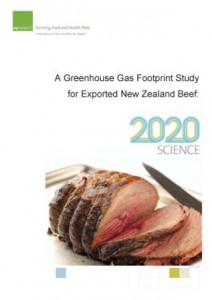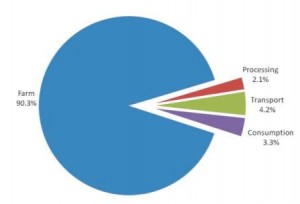 Meat Industry Association (MIA) chief executive Tim Ritchie says that his organisation had supported the study because sustainability is still a critical issue in important markets.
“While it is possibly not as front-of-mind in markets as it was two or three years ago, sustainability remains very important and greenhouse gas emissions are a key component of sustainability.”
The study has created a benchmark for understanding where greenhouse gas (GHG) emissions are occurring across the beef supply chain, including production, processing, transportation and consumption.It has found that the majority (over 90 percent) of emissions occur on the farm. The footprint varies depending on the type of farm, the sex and age of the animals and whether or not animals from the dairy industry are used.
Overall, the weighted New Zealand average GHG emissions from beef animals from sheep and beef farms was 10.5kg CO2-equvalents (CO2-e) per kg of liveweight.Emissions arising from transport to market are extremely low.
Transport accounts for 4.2 percent of emissions, the report shows. In particular, oceanic shipping is very efficient and this study shows it contributes just 1.1-2.7 percent of the total carbon footprint.In addition, consumption accounts for 3.3 percent of emissions whi
Meat Industry Association (MIA) chief executive Tim Ritchie says that his organisation had supported the study because sustainability is still a critical issue in important markets.
“While it is possibly not as front-of-mind in markets as it was two or three years ago, sustainability remains very important and greenhouse gas emissions are a key component of sustainability.”
The study has created a benchmark for understanding where greenhouse gas (GHG) emissions are occurring across the beef supply chain, including production, processing, transportation and consumption.It has found that the majority (over 90 percent) of emissions occur on the farm. The footprint varies depending on the type of farm, the sex and age of the animals and whether or not animals from the dairy industry are used.
Overall, the weighted New Zealand average GHG emissions from beef animals from sheep and beef farms was 10.5kg CO2-equvalents (CO2-e) per kg of liveweight.Emissions arising from transport to market are extremely low.
Transport accounts for 4.2 percent of emissions, the report shows. In particular, oceanic shipping is very efficient and this study shows it contributes just 1.1-2.7 percent of the total carbon footprint.In addition, consumption accounts for 3.3 percent of emissions whi le just 2.1 percent comes from processing, which the report notes “is an area over which industry has direct control and where technologies are available to reduce emissions.”
Dr Stewart Ledgard, the lead author of the report says that until there is a globally-agreed methodology for ‘footprinting’ of meat products, it is hard to assess how New Zealand’s footprint compared to others. This study used the Life Cycle Assessment approach, which is consistent with the PAS2050 published standard for GHG footprinting.The beef study was undertaken by AgResearch and funded by the Meat Industry Association, Ballance Agri-Nutrients, Landcorp and the Ministry for Primary Industries greenhouse gas footprinting strategy. B+LNZ Ltd and individual meat processors provided data and information for the study. This adds to a study already completed on New Zealand lamb’s carbon footprint in 2010.
le just 2.1 percent comes from processing, which the report notes “is an area over which industry has direct control and where technologies are available to reduce emissions.”
Dr Stewart Ledgard, the lead author of the report says that until there is a globally-agreed methodology for ‘footprinting’ of meat products, it is hard to assess how New Zealand’s footprint compared to others. This study used the Life Cycle Assessment approach, which is consistent with the PAS2050 published standard for GHG footprinting.The beef study was undertaken by AgResearch and funded by the Meat Industry Association, Ballance Agri-Nutrients, Landcorp and the Ministry for Primary Industries greenhouse gas footprinting strategy. B+LNZ Ltd and individual meat processors provided data and information for the study. This adds to a study already completed on New Zealand lamb’s carbon footprint in 2010.
More reading: see ‘A Greenhouse Gas Footprint Study for Exported New Zealand Beef’, M Lieffering, S Ledgard, M Boyes & R Kemp, February 2012.
This article appeared in Food NZ magazine (December 2012/January 2013).
